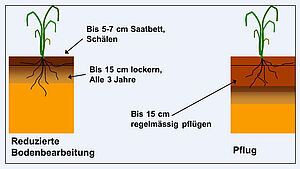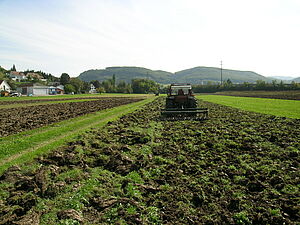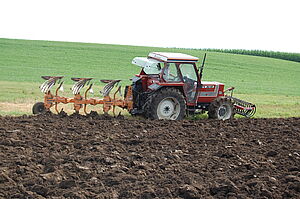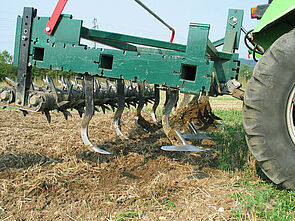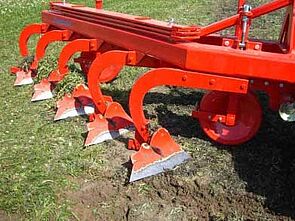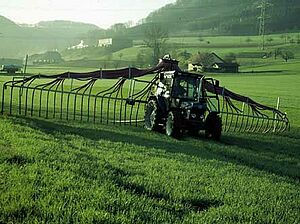More humus – higher biomass activity – more stable soil aggregates – but also more weeds
A long-term plot trial established at Frick, Switzerland in 2002 has been used to study the impact of reduced tillage on soil fertility and yields under organic farming conditions. Additional factors varied in the trial are biodynamic preparations and the form of livestock manure applied, allowing for potential interactions between the three influencing variables to be determined.
Factor 1: Soil cultivation
In the reduced tillage treatment the soil is regularly cultivated and inverted to a depth of only 5 cm. Every few years the soil is loosened to a depth of 15 cm but it is not inverted in the process. Conventional tillage is carried out using a mouldboard plough, inverting the soil to 15 cm depth. Fig.: Alfred Berner, FiBL
Left: Irregular soil clods and grass roots following the use of a stubble cleaner (German: Stoppelhobel, a type of skim plough); Right: After a pass with a chisel plough with rear roller the roots could wither in the late summer heat of September. Winter peas were sown as a green manure in October. Photo: Alfred Berner, FiBL
Soil cultivation using the traditional mouldboard plough in Central Europe severely disturbs the soil every year as the biologically most active topsoil is inverted and thus buried while biologically less active subsoil is brought to the surface, often leading to slaking.
It is for this reason that non-inversion soil cultivation has been advocated time and again. Reduced tillage is well researched and well established in integrated production where the absence of ploughing is balanced out with the aid of herbicides, fungicides, molluscicides and highly soluble nitrogen fertilizers.
In organic farming however, the use of the mouldboard plough appeared to be indispensable for weed and pest control as well as for seedbed preparation, despite its ecologically disruptive impact. Experiences and research trial results in relation to reduced tillage are still scarce but it has become evident that rhizomatous weeds can cause tremendous problems after only a few years of reduced tillage.
In the trial described here we have optimized reduced tillage. Depending on the situation, either a chisel plough or a stubble cleaner are used. A mouldboard plough is used in control plots. The trial is being carried out under normal field conditions using standard farm machinery in a replicated split plot design with subplots nested in large strip-like main plots. It is integrated into the FiBL experimental farm and assistance is being provided by biodynamic farmers as well as by a range of researchers.
Yields under reduced tillage were 10% lower than in the ploughed control in Years 1-3; 20-30% higher in Years 4-7 and 7% lower in years 8-11. Thus, mean yields under reduced tillage over eleven years were 7% higher. Moreover, soils under reduced tillage had 17% more humus (0-10 cm), 37% more microbial biomass, better soil structure and greater water retention capacity. Protein content in cereals was not reduced in the reduced tillage plots.
At the same time however weed infestation was found to be higher in reduced tillage plots. Bindweed, a noxious weed at our site, occurs locally concentrated and so far has been present in both reduced tillage and control plots (for scientific publications see below).
A variety of tools working to different depths can be attached to the Ecodyn cultivator. Photo: Hansueli Dierauer, FiBL
The ‘Stoppelhobel’ is similar to a shallow plough; it undercuts and mixes only the upper soil layer (5 cm). Compared to the chisel plough this shallow inversion of the topsoil achieves better weed suppression. Rhizomatous weeds are systematically cut off. Photo: Alfred Berner, FiBL
Factor 2: Biodynamic preparations
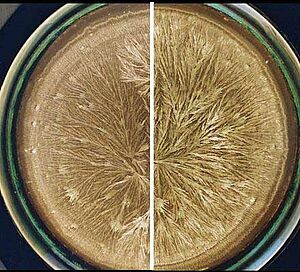
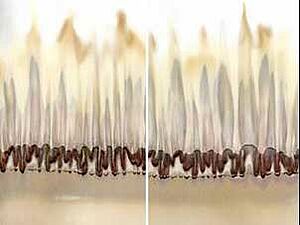
The biodynamic preparations are a cornerstone of biodynamic agriculture. Despite decades of research and practical experience much remains unknown about their effects. The Swiss biodynamic farming association (Schweizer Verein für biologisch-dynamische Landwirtschaft) approached FiBL with a request to investigate and document the preparations’ effects in field trials. Practitioners are particularly interested to know whether biodynamic preparations can only exert their effects in FYM/slurry systems or whether they also work in slurry-only systems.
Field observations had led some farmers to assume that biodynamic preparations can improve soil structure which in turn would make it easier to dispense with ploughing in organic farming.
The use of biodynamic preparations yielded only some limited effects in some years. In the soil, some statistically significant differences could be shown in the microbial C/N ratio, pointing to changes in the ratio between fungi and bacteria.
Factor 3: Factor 3: Livestock manure (slurry vs. farmyard manure)
Slurry-only systems provide benefits in terms of farm economics and labour efficiency. Such systems are often already in place when farmers convert to organic or biodynamic production. In biodynamic farming, however, the use of composted farmyard manure is well established (see DOK trial). The two strategies for fertilizer use differ in their objectives:
- Slurry applications aim at providing plants with directly available nitrogen as much as possible.
- The second strategy aims at enhancing soil life, replenishing humus in the soil, and in turn improving soil structure. Nitrogen for the plants is provided indirectly as a result of the mineralization of labile soil nitrogen fractions.
To date there had not been any comparative investigations of these two fertilizer use strategies in conjunction with different soil cultivation techniques.
So far we have only been able to ascertain that the use of slurry-only compared to the use of composted farmyard manure resulted in higher cereal yields and higher cereal protein contents.
As part of the trial at Frick, greenhouse gas emissions are currently being measured in the various cultivation and fertilizer use variants.
Data from a number of trials in Europe are evaluated in meta-analyses as part of the TILMAN-ORG and BKBA (soil and climate-friendly organic tillage farming) projects: yields and soil organic matter are the main focus of these analyses.
Project partners and funding
Projectmanagement
Project team
Cooperation
- University of Basel: Prof. Dr. Christine Alewell, Prof. Dr. Andres Wiemken, Prof. Dr. Thomas Boller
- University of Geneve HES-SO: Prof. Dr. Pascal Boivin
- University of Barcelona: Prof. Dr. F. Xavier Sans
Funding (all previous sponsors)
- Swiss Federal Office for Agriculture (Bundesamt für Landwirtschaft)
- Maryon Stiftung
- Foundation for People Care, Environmental Care and Earth Care, Switzerland (Stiftung zur Pflege von Mensch, Mitwelt und Erde)
- Software AG Foundation, Germany (Software AG Stiftung) (currently)
- Sampo Foundation, Switzerland (Sampo Stiftung)
- Evidence Foundation, Switzerland (Evidenz Stiftung)
- Coop Sustainability Fund, Switzerland (Coop Fonds für Nachhaltigkeit)
- CORE-Organic, TILMAN-ORG
Publications
Scientific papers
- Armengot, L., Berner, A., Blanco-Moreno, J., Mäder, P., Sans, F.X., 2015. Long-term feasibility of reduced tillage in organic farming. Agron. Sustain. Dev. 35, 339-346
- Berner, A., Hildermann, I., Fließbach, A., Pfiffner, L., Niggli, U., Mäder, P., 2008. Crop yield and soil fertility response to reduced tillage under organic management. Soil Till. Res. 101, 89-96.
- Börstler, B., O. Thiéry, Z. Sykorová, A. Berner und D. Redecker, 2010. Diversity of mitochondrial large subunit rDNA haplotypes of Glomus intraradices in two agricultural field experiments and two semi-natural grasslands. Molecular Ecology 19 (7), 1497-1511.
- Fontana, M., Berner, A., Mäder, P., Lamy, F., Boivin, P., 2015. Soil Organic Carbon and Soil Bio-Physicochemical Properties as Co-Influenced by Tillage Treatment. Soil Sci. Soc. Am. J. 79, 1435-1445.
- Gadermaier, F., Berner, A., Fließbach, A., Friedel, J.K., Mäder, P., 2012. Impact of reduced tillage on soil organic carbon and nutrient budgets under organic farming. Renew. Agr. Food Syst. 27, 1-13.
Krauss, M., Berner, A., Burger, D., Wiemken, A., Niggli, U., Mäder, P., 2010. Reduced tillage in temperate organic farming: implications for crop management and forage production. Soil Use and Management 26, 12-20. - Krauss, M., Berner, A., Perrochet, F., Frei, R., Niggli, U., Mäder, P., 2020. Enhanced soil quality with reduced tillage and solid manures in organic farming - a synthesis of 15 years. Scientific Reports, 10, S. 4430.
- Krauss, M., Krause, H.-M., Spangler, S., Kandeler, E., Behrens, S., Kappler, A., Mäder, P., Gattinger, A., 2017. Tillage system affects fertilizer-induced nitrous oxide emissions. Biology and Fertility of Soils, 53, 49–59.
- Krauss, M., Ruser, R., Müller, T., Hansen, S., Mäder, P., Gattinger, A., 2017. Impact of reduced tillage on greenhouse gas emissions and soil carbon stocks in an organic grass-clover ley - winter wheat cropping sequence. Agriculture, Ecosystems & Environment 239, 324-333.
- Kuntz, M., Berner, A., Gattinger, A., Scholberg, J.M., Mäder, P., Pfiffner, L., 2013. Influence of reduced tillage on earthworm and microbial communities under organic arable farming. Pedobiologia 56, 251-260.
- Mäder, P., Berner, A., 2012. Development of reduced tillage systems in organic farming in Europe. Renew. Agr. Food Syst. 27, 7-11.
- Säle, V., Aguilera, P., Laczko, E., Mäder, P., Berner, A., Zihlmann, U., van der Heijden, M.G.A., Oehl, F., 2015. Impact of conservation tillage and organic farming on the diversity of arbuscular mycorrhizal fungi. Soil Biology and Biochemistry 84, 38-52.
- Sans, F.X., Berner, A., Armengot, L., Mäder, P., 2011. Tillage effects on weed communities in an organic winter wheat–sunflower–spelt cropping sequence. Weed Research 51, 413-421.
Articles for practitioners
- Berner, A., 2011. Den Fruchtfolgeflächen geht es nicht sehr gut. Bauernzeitung. 17.Juni 2011. S. 31
- Berner, A., Mäder, P., Messmer, M., Fliessbach, A., Krauss, M., Dierauer, H., Clerc, M., Koller, M., Meier, M., Schader, C., 2012. Reduzierte Bearbeitung – fruchtbarere Böden? Ergebnisse aus Parzellenversuchen und von Praxisbetrieben. Lebendige Erde, 3, 40-43.
- Berner, A., Mäder, P., Spiegel, A.-K., 2011. Für die Bodenfruchtbarkeit ist weniger mehr. Landwirtschaft ohne Pflug LOP. Sonderheft.
- Berner, A., Messmer, M., Mäder, P., 2010. Gut für den Boden, gut fürs Klima. Bioland 01, S. 14-15.
- Bofru, 2010. Reduzierte Bodenbearbeitung: geht das im Ökolandbau? Projekt Bodenfruchtbarkeit.
- Clerc, M., 2010. Le travail réduit du sol en bio.
- Clerc, M., 2012. Travail réduit du sol en conditions bio: résultats technico-économiques.
- Clerc, M., 2012. Rendement: Travail réduit du sol en bio: bilan technico-économique. Agrihebdo, 30.3.2012.
- Clerc, M., Mäder, P., Berner, A., 2010. Le bio en bref. Le travail réduit du sol est-il possible? Agri 7.5.2010.
- Kessler, H.G., 2011. Bioackerbau soll noch klimaschonender werden. Die Grüne 16.06.2011. S. 32.
- Krauss, M., Perrochet, F., Grosse, M., Mäder, P. (2021). Biodynamische Präparate im Ackerbau. Ergebnisse aus einem Langzeitversuch in Frick in der Schweiz. Lebendige Erde, 6-2021, S. 41-45.
- Mäder, P., Berner, A., Messmer, M., Fliessbach, A., Krauss, M., Dierauer, H., Clerc, M., Koller, M., Meier, M., Schader, C., 2012. Reduzierte Bodenbearbeitung. Deutliche Vorteile für Bodenfruchtbarkeit. Ökologie & Landbau 162, 2, 25-27.
- Mäder, P., Dierauer, H.U., 2012. Klimaschonender Ackerbau durch reduzierte Bodenbearbeitung. Bioaktuell 5, 13-17.
- Roggli, M., 2010. Vielversprechende Resultate. UFA-Revue 3.2.2010.




